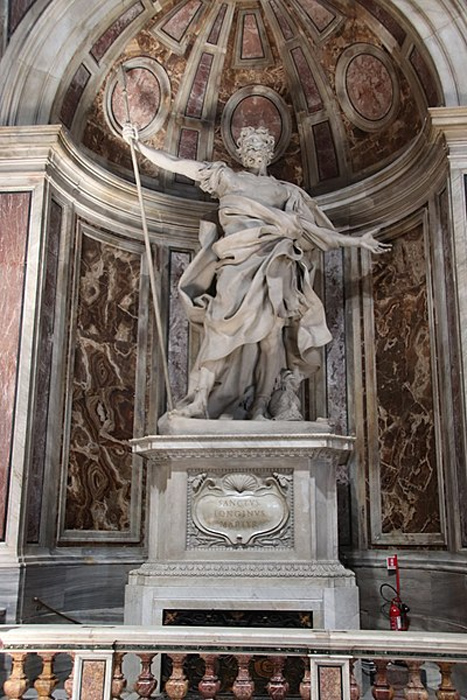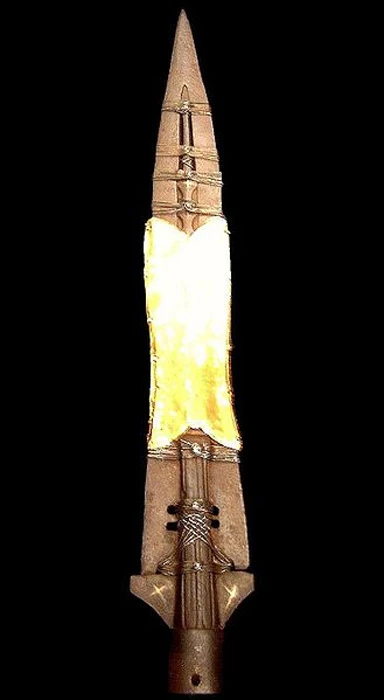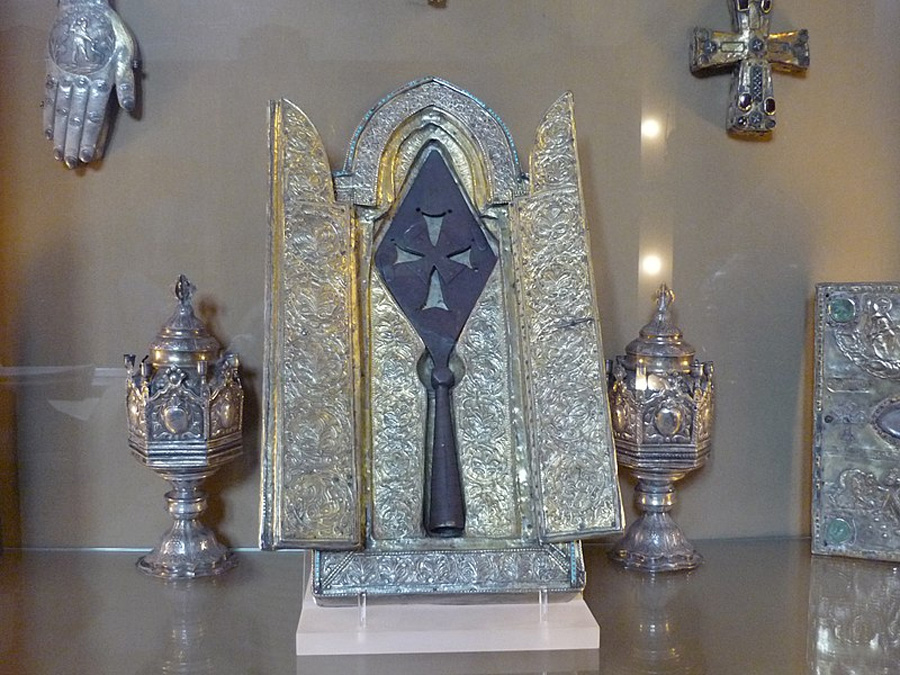Christian history is littered with relics. The bones of saints, clothing, even entire bodies are kept in places of honor in the great cathedrals of Europe and beyond.
Of these relics, the most prized and the most holy are those associated with Christ himself. And of these, the most sought after of all, perhaps only equaled by the Holy Grail, is the Holy Lance of Longinus.
This legendary relic is the spear that pierced the side of Jesus Christ at the crucifixion. Mentioned only in the Gospel of John, it was stabbed into Jesus to demonstrate that he had already died, so that his body could be taken down and entombed according to Jewish laws of the Sabbath.
Named for Saint Longinus, the Roman soldier who stabbed Christ to show he was dead, the Holy Lance has many names. It has been called the Spear of Destiny or the Holy Spear. And this simple spear has, throughout history, been preserved in various great Christian churches, down even to the present day.
Or has it? There are at least four current ancient spearheads which claim to come from the Spear of Longinus. Which of them is the true Holy Lance? Are any of them truly the spear that stabbed Jesus?
What was the Spear of Longinus?
According to the Gospel of John, the Roman soldiers who guarded the three crosses of the crucifixion intended to break Jesus’s legs on the cross. This may sound barbaric but would have been a mercy as breaking his legs in this way would hasten his death and end his suffering, but it was clear that the Romans thought Jesus was still alive.
However Jewish custom required that Jesus be taken down and entombed on the Sabbath eve (before Saturday sundown) to avoid any manual labor on the Jewish Sabbath. While discussing this with the Romans they noticed that Jesus appeared to be already dead, and therefore it was unnecessary to break his bones.

To confirm Jesus was dead, a Roman soldier thrust his spear into the side of Jesus as he lay on the cross. A mass of blood and water rushed out of the wound, but Jesus made no movement and no sound, confirming he was dead. He was then taken down from the cross.
- The Sacro Catino: Did Napoleon break the Holy Grail?
- Land of the Rising Sun: Did Jesus Retire To Rural Japan?
The soldier was not named in the Bible but the wider biblical apocrypha does give a name. In the Gospel of Nicodemus the soldier is described as a Roman centurion named Longinus. However best estimates put the authorship of this gospel some time around the 4th century, much later than the canonical gospels, and if this name is correct it must have survived through some other tradition now lost to us.
What happened to the Spear?
The Bible never mentions the spear again and it was not considered important until the days of the early Church. As the religion Jesus founded and espoused grew, so did the appetite for finding artifacts mentioned in the New Testament, and a great search for the spear began.
There are four main contenders for the spear today, each of which has its own competing provenance and each of which has considerable gaps in its history. For a start there are centuries of silence between the crucifixion and the first appearance of a Holy Lance.
The main contender for the real spear is kept underneath the vast dome of St Peter’s Basilica in Rome. The relic here is apparently the same one as was described by a pilgrim to Jerusalem in 570 AD who described seeing “the crown of thorns with which Our Lord was crowned and the lance with which He was struck in the side”.
After the Persian conquest of Jerusalem in 615 AD this spear was apparently broken into two pieces, the point and the blade. The point travelled to Constantinople and was later sold to Louis IX of France, moving again to Paris. From there it disappeared during the French Revolution.
The larger blade of the spear may also have travelled to Constantinople, but descriptions of the time do not always distinguish between the two parts of the Holy Lance. However there was definitely another part of the spear at Constantinople, as it was looted by the Ottoman Turks when they sacked the city in 1492.
From there the Ottoman Sultan offered what was apparently the blade to Pope Innocent VIII. Although skeptical as to its authenticity due to the huge gaps in its documented history, the spear has remained there ever since.
Other Contenders
In the Imperial Treasury held in the grand Hofburg Palace of Vienna in Austria, another spear can also be found. The provenance of this lance is perhaps even more problematic than the one in Rome, and through its known history it has been referred to as many things.

In its early history it was known as the Spear of Constantine the Great, or the Egyptian 3rd century military leader Saint Maurice. However other stories began to swirl around this lancehead from the 10th century, when it came into the possession of the Holy Roman Emperors.
Henry IV, in the year of his coronation as Emperor, claimed that the spear had a nail on its tip which was from the cross used to crucify Jesus. Almost 300 years later the lance was again upgraded and was now claimed to be made of both a nail from the cross and the Holy Lance itself.
- The Holy Foreskin: Where is the Last Piece of the Body of Christ?
- Why was the Infancy Gospel of Thomas Excluded from the Bible?
This apparent bolstering of the credentials of this lance is not the only problem. Modern X-ray analysis of the metal concludes that both the spear and the nail likely date from the 8th century, much too late for the artifact to be what it claims.
A spear is also preserved in Vagharshapat, one of the principal and oldest cities in Armenia. Again a huge gap in the historical record exists where the spear is undocumented, with the first reference to it appearing as late as the 13th century.
According to this account, the Vagharshapat spear was apparently brought to Armenia by the Apostle Thaddeus, one of Jesus’s twelve disciples. However no corroborating evidence from any earlier sources supports this account.

The final contender for the Spear of Longinus rests in the city of Antioch, in the Middle East. In 1098, during the siege of Antioch in the First Crusade, a monk named Peter Bartholomew had a vision in which he was told by St. Andrew that the Holy Lance was buried in a church in the city.
After conducting excavations in the church Peter produced a spearhead which he claimed to be the Spear of Longinus. No other provenance exists for this spear, which therefore must have the weakest claim from history to be the spear.
Finding the Real Spear
And so it can be seen that none of the current spearheads have sufficient evidence to allow for a dispassionate confirmation that they are indeed, the spear that pierced the side of Jesus Christ. However, while this may discredit the current contenders, it does also offer somewhere to look.
The point of the spear lost in the French Revolution can apparently trace its provenance back to multiple attestations in Jerusalem, which would seem to give it a more secure history than its rivals. And it was lost comparatively recently in history, and may conceivably be hidden still in some dusty attic of sealed crypt.
And the larger blade, if it is not the one in Rome, could only be in a number of places. It may still be in Constantinople, or preserved amongst the treasures of the Sultan who supposedly gifted it to the Pope after he sacked the city. Or perhaps it never left Jerusalem at all.
The Vatican does not recognize any of the current contenders as the true Holy Lance. At least, for those hoping to find it, there is somewhere they can start.
Top Image: Longinus pierces the side of Jesus on the cross. Source: Gerard de la Vallée / Public Domain.
By Bipin Dimri